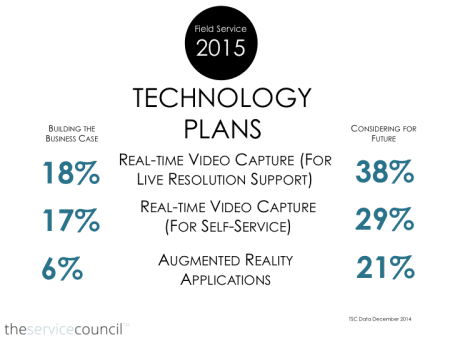Peek inside any field service tech’s toolkit these days and, chances are, you’ll spot at least one device capable of streaming video. That smartphone tucked inside a tech’s pocket, or an iPad tucked under his arm, are really high-tech camcorders capable of beaming live video to coworkers across town — or halfway around the world. Amazing, right? So why are so few service organizations actually using that technology to improve first-time fix rates, training and other critical factors in field service?
The Service Council’s Sumair Dutta isn’t surprised, but he says the field service industry isn’t necessarily lagging behind, either. “I have yet to see a lot of organizations in other industries use streaming video effectively.”
Dutta is bullish on video’s prospects in the field — and, as his latest research suggests, so are field service leaders. Here, he discusses the growing industry-wide enthusiasm for video, and what big changes are around the corner.
Technicians are carrying devices that can stream high-quality video, and the benefits are clear. So, why isn’t video a must-have tool at this point?
 Dutta: Field service tends to be cautious about technology adoption. There are some exceptions, obviously, but if you think about general mobility, there are still a lot of organizations that run their businesses on pen and paper. So, I don’t think it’s surprising that service companies have been slow to adopt streaming video. Companies need to initiate that change before they can start thinking about what technicians should do with those devices.
Dutta: Field service tends to be cautious about technology adoption. There are some exceptions, obviously, but if you think about general mobility, there are still a lot of organizations that run their businesses on pen and paper. So, I don’t think it’s surprising that service companies have been slow to adopt streaming video. Companies need to initiate that change before they can start thinking about what technicians should do with those devices.
But we’re beginning to see a comfort level with mobile technologies, so there’s more discussion around tools like video, messaging, social collaboration and other functionality enabled by mobile devices.
For companies that have already ‘gone mobile,’ how excited are they about live video?
At this stage, it’s still largely a ‘nice-to-have’ feature. There just aren’t many use cases of companies that are already using streaming video to improve field-based resolution.
That’s why I was a bit surprised when our research revealed that 18 percent of surveyed companies have active projects in place evaluating how real-time video could change their live resolution support. That might not seem like a lot, but it’s one-in-five companies, which is significantly more than we’ve seen in the past. What’s more, an additional 38 percent of companies said they are considering video in the future. These aren’t companies with active projects, but they recognize video’s value and need to consider the logistics to make it work.

Image: The Service Council
It’s easy to imagine video’s benefits for troubleshooting. But what about its future impact on training — especially with so many technicians nearing retirement?
Longer term, I think this is the biggest reason for the interest in video. Every company we’re talking to has some discussion around training. They’re asking: How do we transfer the knowledge of current employees to educate the next wave of employees? Video is one tool managers can use to quickly train employees so they can be sent into the field. It will also have a significant impact on training for specific scenarios by having procedures documented and readily available via mobile devices.
“Longer term, I think [training] is the biggest reason for the interest in video.” — Sumair Dutta
And it’s important demographically. Younger technicians expect to learn through video because it’s what they do in their own lives. Service companies should teach their employees in the manner they prefer to learn.
Will companies struggle to get employees to use video in the field?
Service leaders who make the leap will have to wrestle with some big questions like: Should my existing workforce use video, or do I just focus on new hires? It’ll be interesting to see how workers — young and old alike — respond to video and other new technologies.
Looking further around the bend, is there a future for augmented reality tools in field service?
It’s really difficult to predict what’s coming technologically in five, 10 years. Sure, I can see the applicability of augmented reality in field service. Being able to show technicians in the field — visually, not just via audio — how to fix a problem would be powerful. Beyond that, imagine if a technician could walk into a customer location and not only view every asset that’s maintained by his or her company, but also see specific details like the date of the last preventative maintenance checkup. I have to think it will become a reality at some point, but it’s still very, very early.


A good place to find out about opportunities for augmented reality technologies in field service (and other areas) is at Augmented World Expo (AWE) – http://augmentedworldexpo.com/.